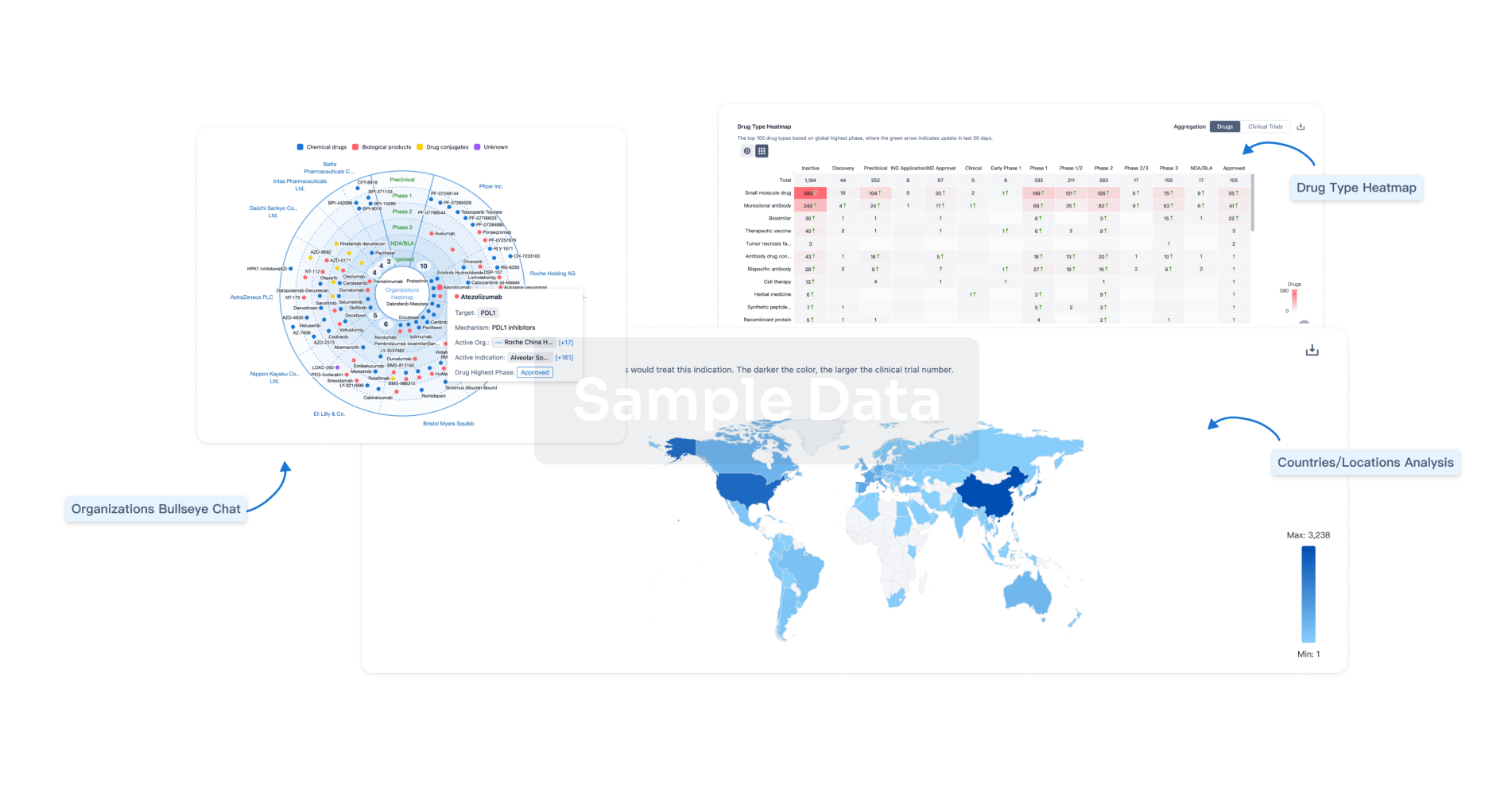Request Demo
Last update 08 May 2025
Ischemic stroke
Last update 08 May 2025
Basic Info
Synonyms Ischaemic Stroke, Ischaemic Strokes, Ischaemic stroke + [21] |
Introduction Stroke due to BRAIN ISCHEMIA resulting in interruption or reduction of blood flow to a part of the brain. When obstruction is due to a BLOOD CLOT formed within in a cerebral blood vessel it is a thrombotic stroke. When obstruction is formed elsewhere and moved to block a cerebral blood vessel (see CEREBRAL EMBOLISM) it is referred to as embolic stroke. Wake-up stroke refers to ischemic stroke occurring during sleep while cryptogenic stroke refers to ischemic stroke of unknown origin. |
Related
357
Drugs associated with Ischemic strokeTarget- |
Mechanism Cell replacements |
Active Org. |
Originator Org. |
Active Indication |
Inactive Indication- |
Drug Highest PhaseApproved |
First Approval Ctry. / Loc. United States |
First Approval Date20 Nov 2024 |
Target |
Mechanism NGF modulators [+1] |
Active Org. |
Originator Org. |
Active Indication |
Inactive Indication |
Drug Highest PhaseApproved |
First Approval Ctry. / Loc. Japan |
First Approval Date31 Jul 2024 |
Target |
Mechanism ETB agonists [+3] |
Active Org. |
Originator Org. |
Active Indication |
Inactive Indication |
Drug Highest PhaseApproved |
First Approval Ctry. / Loc. India |
First Approval Date31 May 2023 |
4,579
Clinical Trials associated with Ischemic strokeNCT06919835
CiLostAzol for pReventIon of Recurrent sTroke in Africa
Global estimates suggest that sub-Saharan Africa (SSA) now has the highest incidence, prevalence, and worst survival outcomes of stroke. With an estimated 1.4 million stroke survivors, outcomes of stroke in SSA are abysmal with 1-month case fatality at 30% and 3-year mortality rate of 84%. Stroke survivors in Africa are at an inordinately high (and worsening) risk of adverse outcomes including recurrent stroke and cardiac events over the medium- to longterm. Given the paucity of resources in the region, testing of therapies, which are potentially highly clinically efficacious and cost-effective, while developing local stroke research capacity and contributing to the global secondary stroke prevention evidence base, is urgently needed. Cilostazol, a phosphodiesterase 3 inhibitor, has shown promising efficacy and safety mainly among an Asian population by cutting risk of major adverse cardiovascular events including stroke, in half, when added to aspirin or clopidogrel (8% vs. 4%, HR 0.52, 95% CI 0.35-0.77), with no increased risk in bleeding or serious adverse events. Cilostazol's potentially strong efficacy, presumed pleiotropic effects, and relatively low cost, make it a highly appealing agent for use in stroke-prone, low-resource settings. Therefore, the overall objective of the CiLostAzol for pReventIon of recurrent sTroke in Africa (CLARITY-AFRICA) study is to deploy a hybrid study design to demonstrate the efficacy and safety of cilostazol twice daily in reducing MACE over 24 months vs. placebo among 1100 recent stroke patients encountered at 12 hospitals in Ghana. Secondly, CLARITY-AFRICA also seeks to develop an implementation strategy for routine integration and policy adoption of cilostazol for post-stroke cardiovascular risk reduction in an under-resourced system. Given its compelling efficacy among a predominantly Asian population, the National Institute of Neurological Disorders and Stroke (NINDS) is poised to fund a US-based clinical trial to assess the longer-term efficacy and safety of cilostazol in a study titled CiLostAzol for pReventIon of recurrent sTroke (CLARITY). The investigators are also aware that European and Australian funding agencies are considering stroke trials of cilostazol. A concurrently executed CLARITYAfrica trial would allow recruitment of a historically underrepresented and high-risk group (Africans), test a therapy that if efficacious could be affordable for broader regional implementation, permit transcontinental mentorship/collaborations, and leverage NINDS impending investment. CLARITY-AFRICA will assess implementation outcomes such as adoption, acceptability, cost, pertinent to uptake of cilostazol in Ghana to inform policy. Regardless of its outcome, findings from CLARITYAFRICA will contribute meaningful information from the African perspective to inform the formulation of guidelines for global adoption of cilostazol into routine care for secondary CVD risk prevention by international bodies such as the World Health Organization. This application will focus on the first 2 aims of CLARITY-AFRICA to conduct the trial and assess secondary outcomes.
Start Date01 Aug 2027 |
Sponsor / Collaborator |
ACTRN12624001066572
Co-designing and evaluating the implementation of clinical pathways for acute care in Tasmania
Start Date01 Jan 2026 |
Sponsor / Collaborator |
NCT06442631
An Individualized Video-based Stroke Education Platform for Stroke Survivors and Caregivers
The goal of this multicenter randomized trial is to evaluate the impact of a personalized video-based stroke education platform on patient-centered and health system-centered outcomes. The main questions this study aims to address are:
1. Does a personalized, video-based educational platform improve stroke knowledge?
2. Does a personalized, video-based educational platform reduce post-discharge health system utilization?
3. Do different strategies of nudging improve engagement with educational material after hospital discharge?
In order to determine the effect of this personalized stroke education strategy, researchers will compare subjects who receive standard stroke education with those who receive the personalized stroke education platform in addition to standard standard education. Patient knowledge will be assessed 90-days after discharge. Study participants will include both stroke patients and caregivers, who will:
1. Receive standard education during the stroke hospitalization
2. Complete a survey on the day of hospital discharge to assess their baseline knowledge.
3. Half of the subjects will be randomly assigned to also receive access to the personalized stroke education platform on the day of discharge.
4. All subjects will complete two follow-up study visits (7 and 90 days after discharge) in order to complete surveys.
1. Does a personalized, video-based educational platform improve stroke knowledge?
2. Does a personalized, video-based educational platform reduce post-discharge health system utilization?
3. Do different strategies of nudging improve engagement with educational material after hospital discharge?
In order to determine the effect of this personalized stroke education strategy, researchers will compare subjects who receive standard stroke education with those who receive the personalized stroke education platform in addition to standard standard education. Patient knowledge will be assessed 90-days after discharge. Study participants will include both stroke patients and caregivers, who will:
1. Receive standard education during the stroke hospitalization
2. Complete a survey on the day of hospital discharge to assess their baseline knowledge.
3. Half of the subjects will be randomly assigned to also receive access to the personalized stroke education platform on the day of discharge.
4. All subjects will complete two follow-up study visits (7 and 90 days after discharge) in order to complete surveys.
Start Date01 Jan 2026 |
Sponsor / Collaborator |
100 Clinical Results associated with Ischemic stroke
Login to view more data
100 Translational Medicine associated with Ischemic stroke
Login to view more data
0 Patents (Medical) associated with Ischemic stroke
Login to view more data
94,788
Literatures (Medical) associated with Ischemic stroke01 Jan 2026·Neural Regeneration Research
Enhanced neurogenesis after ischemic stroke: The interplay between endogenous and exogenous stem cells
Article
Author: Wang, Yuhe ; Geng, Ruxu ; Wu, Jun ; Wang, Renzhi ; Bao, Xinjie
01 Jan 2026·Neural Regeneration Research
Changes in border-associated macrophages after stroke: Single-cell sequencing analysis
Article
Author: Zhang, Fuqiang ; Yu, Ning ; Wang, Shilei ; Wang, Peng ; Wen, Cuili ; Zhao, Yang
31 Dec 2025·Future Science OA
The association between whole blood viscosity and CHA2DS2-VASc/CHA2DS2-VA scores in patients with atrial fibrillation
Article
Author: Kalenderoglu, Koray ; Kahraman, Erkan
876
News (Medical) associated with Ischemic stroke24 Apr 2025
GOSSELIES, Belgium I April 24, 2025 I
Bioxodes SA, a clinical stage biopharmaceutical company developing novel therapies for the prevention and treatment of thrombotic and inflammatory diseases, today announces promising interim results from the BIRCH Phase 2a clinical trial of its lead asset, BIOX-101, to treat intracerebral hemorrhagic stroke (ICH). Interim analysis from the first 16 patients in the standard-of-care controlled, randomized trial showed that primary safety and secondary efficacy endpoints were met. The Data Monitoring Committee (DMC) identified no safety concerns related to changes in ICH volumes, serious adverse events, neurological outcomes, or mortality.
Bioxodes will release a second interim report in the second half of 2025, and a final analysis of the study in 2026. The company has stopped recruitment for the trial, as it believes that adding more data would not alter the conclusions based on the available findings. Bioxodes will now start preparing the launch of a potentially registrational Phase 2b trial of BIOX-101 in ICH.
“While preliminary, the data from this study all point in the right direction. This excellent result has given us the confidence to start the Phase 2b trial as soon as possible,” said
Hans Warrinnier, Chief Medical Officer
at Bioxodes. “Although hemorrhagic stroke often has debilitating consequences, it is a neglected disease, and the prospect of offering these patients hope is a strong motivating factor for our team.”
“These encouraging results are an important milestone, which enables us to start looking ahead. We will now launch a Series B funding round, and start the CMC process required to produce sufficient BIOX-101 for the Phase 2b trial. This will take approximately a year to complete, so that we hope to start recruitment in the first half of 2027,” said
Marc Dechamps, Chief Executive Officer
at Bioxodes.
No deaths have so far been recorded in the patient population, a surprisingly positive outcome, and no serious adverse events were attributed to treatment over the course of the trial. Treatment was well-tolerated, with no signs of increased bleeding. Data showed a consistent exposure to the drug during infusion, while pharmacodynamic data aligned well with pharmacokinetic findings. Imaging data suggested a favorable evolution of hematoma and edema volumes, while exploratory outcomes on inflammation biomarkers measurements were very encouraging.
ICH is a devastating condition, which while accounting for only 13% of all cases of stroke, is behind 40% of all stroke-related deaths. There is currently no approved treatment, and many survivors are left with permanent or long-term disability. Bioxodes received Orphan Drug Designation for BIOX-101 in both the U.S. and in Europe in March 2025. The company is planning to file for PRIME status with the EMA later in 2025, and for Fast Track designation with the FDA later during development of the product. The planned Phase 2b trial could be sufficient to submit BIOX-101 for conditional marketing authorizations in the U.S. and Europe before 2030.
BIOX-101
is a recombinant version of a small protein found in the saliva of the tick (
Ixodes ricinus
). It is designed to inhibit the harmful secondary effects of hemorrhagic stroke such as secondary ischemia, neuroinflammation and neuronal damage. The product exerts its anti-inflammatory effects by inhibiting activation of neutrophils and their release of extracellular DNA filaments (called NETs), which can cause excessive inflammation, exacerbating brain damage and disrupting the blood-brain barrier. Unlike currently marketed anticoagulants, BIOX-101 reduces clotting without increasing bleeding, by targeting Factors XIa and XIIa of the intrinsic coagulation pathway. Bioxodes is currently investigating the possibilities of a Phase 2 trial with BIOX-101 in acute ischemic stroke.
Bioxodes SA (www.bioxodes.com)
is a clinical stage biopharmaceutical company developing novel therapies for the prevention and treatment of thrombotic and inflammatory diseases. The company’s lead asset, BIOX-101, is a first-in-class drug candidate being developed to treat thromboinflammatory disease. BIOX-101’s unique mechanism of action is the foundation of an innovative pipeline of drug candidates for the prevention of (thrombo)inflammatory diseases. Worldwide, Bioxodes holds both granted and pending patents associated with BIOX-101. Bioxodes research is supported by the Walloon Region, and the company is registered in Belgium under number
825.151.779
.
SOURCE:
Bioxodes
Phase 2Orphan DrugFast TrackClinical Result
15 Apr 2025
The U.S. Phase 2 trial aims to evaluate efficacy and safety of CX11 in doses up to 200 mg and different titration schemesThe trial is expected to enroll 250 patients to receive treatment over 36 weeks BERKELEY HEIGHTS, N.J., April 15, 2025 (GLOBE NEWSWIRE) -- Corxel Pharmaceuticals Limited (CORXEL), a clinical-stage biopharmaceutical company dedicated to developing innovative therapies for patients with cardiometabolic conditions around the world, today announced the clearance of an investigational new drug (IND) application by the U.S. Food and Drug Administration (FDA) for a U.S. Phase 2 trial of CX11, an investigational oral once-daily small molecule glucagon-like peptide-1 receptor agonist (GLP-1 RA). This randomized, double-blind, placebo-controlled trial will evaluate the efficacy and safety of CX11 in patients with obesity and overweight conditions in the U.S., with enrollment expected to begin in the second quarter of 2025. CX11 (also known as “VCT220”), for which CORXEL acquired global ex-China rights from Suzhou Vincentage Pharma Co., Ltd (Vincentage) in December 2024, is a once-daily oral product candidate designed to offer a convenient alternative to injectable GLP-1 treatments. In a previous Phase 2 trial conducted by Vincentage in China, CX11 achieved competitive weight loss with favorable safety and tolerability. CORXEL’s U.S. Phase 2 trial targets to enroll 250 patients, including those with a BMI of ≥30 kg/m² or a BMI of ≥27 kg/m² with at least one weight-related comorbidity, to receive treatment over 36 weeks and to be further monitored over a 2-week follow-up period. Topline data from this trial is expected in the first half of 2026, and if positive, would pave the way for a global Phase 3 development. CORXEL’s partner Vincentage initiated a Phase 3 registrational obesity trial in China in November 2024. “We are excited to receive the Study May Proceed Letter from the FDA for the U.S. Phase 2 trial of CX11, a critical milestone in our mission to address the global burden of obesity and related cardiometabolic diseases,” said Bo Liang, Senior Vice President, Head of Clinical Development – Metabolic at CORXEL. “Currently approved GLP-1 therapies, while generally effective, often face obstacles such as weekly injections, titration difficulty, side effects and limited tolerability, maintaining weight loss and supply challenges for peptide-based therapies. With once-daily oral administration and promising clinical data, CX11 aims to address these issues, potentially offering a best-in-class convenient oral treatment solution for patients globally.” About CX11 CX11 is an investigational oral small molecule GLP-1 RA designed to address cardiometabolic conditions, with a primary focus on obese and overweight patients. With global ex-China rights acquired by CORXEL from Vincentage in December 2024, CX11 aims to overcome limitations of current injectable GLP-1 RAs by offering convenient, once-daily oral administration, weight reduction comparable to injectable GLP-1 RAs, favorable tolerability results, scalability and accessibility as a small molecule product candidate. Clinical data from Vincentage’s Phase 2 trial in China demonstrated competitive weight loss with a favorable safety and tolerability profile. CX11 is currently advancing into a U.S. Phase 2 trial by CORXEL and through a Phase 3 registrational trial in China conducted by Vincentage, positioning it as a potential best-in-class oral therapy for management of obesity and overweight conditions. About CORXEL’s U.S. Phase 2 Clinical Trial for CX11 CX11’s U.S. Phase 2 clinical trial is a randomized, double-blind, placebo-controlled trial, designed to assess the efficacy and safety profile of CX11 in individuals with obesity and overweight in the United States. The trial targets to enroll 250 patients, including those with a BMI of ≥30 kg/m² or a BMI of ≥27 kg/m² with at least one weight-related comorbidity. The trial will feature five treatment arms: four active treatment groups receiving 120 mg, 160 mg, 200 mg with fast titration, 200 mg with slow titration, of CX11, as well as a placebo group. Patients will receive treatment for 36 weeks and will be further monitored over a 2-week follow-up period. Topline data from this trial is expected to be released in the first half of 2026. About CORXEL CORXEL is a clinical-stage biopharmaceutical company dedicated to developing innovative therapies for patients with cardiometabolic conditions around the world. CORXEL is led by an experienced management team that has a strong track record of identifying, in-licensing and developing attractive clinical product candidates directed at validated targets with proven mechanisms of action (MoAs). CORXEL’s diverse portfolio of clinical-stage product candidates has the potential to redefine treatment standards and address key limitations of current therapies for multiple cardiometabolic indications. CORXEL is developing selective small molecule compounds across the cardiometabolic spectrum with the lead product candidate CX11, an oral GLP-1 receptor agonist (GLP-1 RA) for obese and overweight patients, JX10, a thrombolytic and anti-inflammatory agent for acute ischemic stroke (AIS) and JX09, a highly selective aldosterone synthase inhibitor (ASI) for hypertension. For further information about CORXEL, please visit www.corxelbio.com media@corxelbio.com
Phase 2INDClinical Result
15 Apr 2025
- The universal oxygen carrier delivery capabilities of BXT-25 can be monitored, broadening its applications to treat hypoxic diseases
- Leading drug candidate ProLectin-M targets galectins in viral infections including bird flu like viruses
April 11, 2025 -- BIOXYTRAN, INC. (OTCQB: BIXT) (the “Company”), a clinical stage biotechnology company developing novel therapies targeting hypoxia and mitochondrial dysfunction, today highlighted the historical and scientific significance of fiber optic–based fluorometry in brain mitochondrial research. A landmark paper by Prof. Avraham Mayevsky of Bar-Ilan University was published in a book compiled by editor George Laliotis which covered key areas of biological science. Bioxytran believes this is a milestone achievement because the study, commemorates 50 years of in vivo NADH redox state monitoring, highlighting the pivotal role of mitochondrial function in cellular health. This is a cornerstone of Bioxytran’s BXT-25 drug development program.
The recent paper emphasizes the significance of real-time mitochondrial monitoring, particularly in addressing mitochondrial dysfunction and hypoxia—key contributors to diseases like stroke.
The groundbreaking work of Prof. Mayevsky, which introduced UV-transmitting optical fibers for tracking NADH fluorescence in vivo, paved the way for development of the MDX Viewer with is an FDA approved device that measures tissue metabolic score in real time.
Bioxytran is advancing BXT-25 toward Phase 1 trials for conditions where an oxygen transport carrier is needed to burrow through blood clots including ischemic stroke, heart attack, pulmonary embolism, chronic kidney disease (CKD), and Long Covid. The company is also exploring partnerships to integrate next-generation monitoring technologies for patient selection and use as a new vital sign.
“This anniversary paper mirrors our mission at Bioxytran —to translate decades of foundational science into life-saving therapies,” stated David Platt, CEO of Bioxytran Inc. “BXT-25 builds on these principles by directly addressing the mitochondrial dysfunction observed in hypoxia-related diseases. Prof. Mayevsky’s work validates the urgency of our clinical efforts."
Bioxytran, Inc. is at the forefront of developing complex carbohydrate-based therapeutics to address critical unmet medical needs in its three core platform technologies. These include virology, cancer metastasis, and oxygen transport. In addition to ProLectin-M, Bioxytran is advancing programs for pulmonary fibrosis and stroke treatment.
The content above comes from the network. if any infringement, please contact us to modify.
Analysis
Perform a panoramic analysis of this field.
login
or

AI Agents Built for Biopharma Breakthroughs
Accelerate discovery. Empower decisions. Transform outcomes.
Get started for free today!
Accelerate Strategic R&D decision making with Synapse, PatSnap’s AI-powered Connected Innovation Intelligence Platform Built for Life Sciences Professionals.
Start your data trial now!
Synapse data is also accessible to external entities via APIs or data packages. Empower better decisions with the latest in pharmaceutical intelligence.
Bio
Bio Sequences Search & Analysis
Sign up for free
Chemical
Chemical Structures Search & Analysis
Sign up for free






